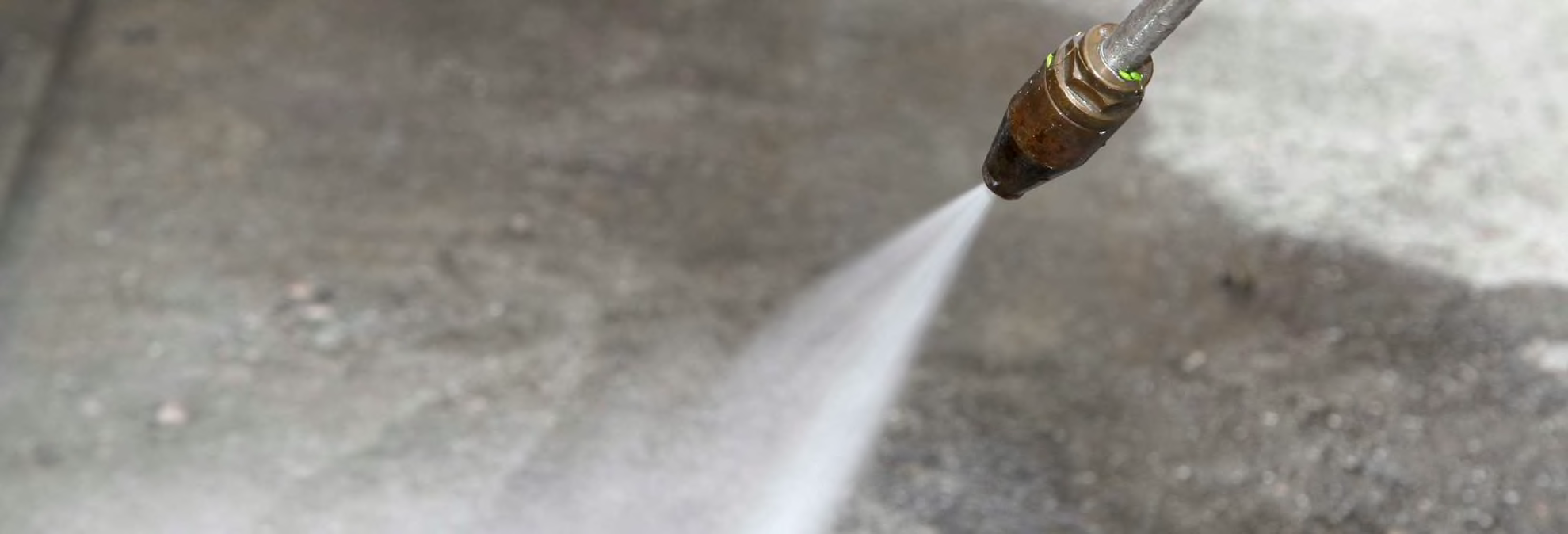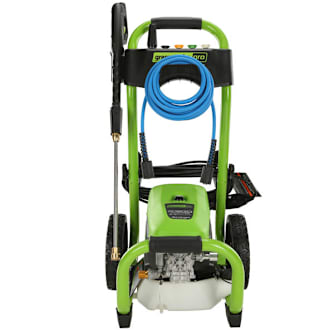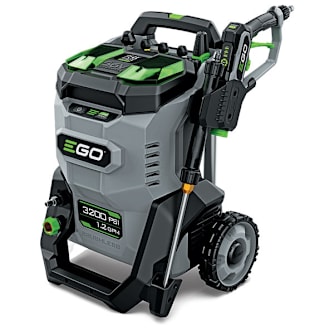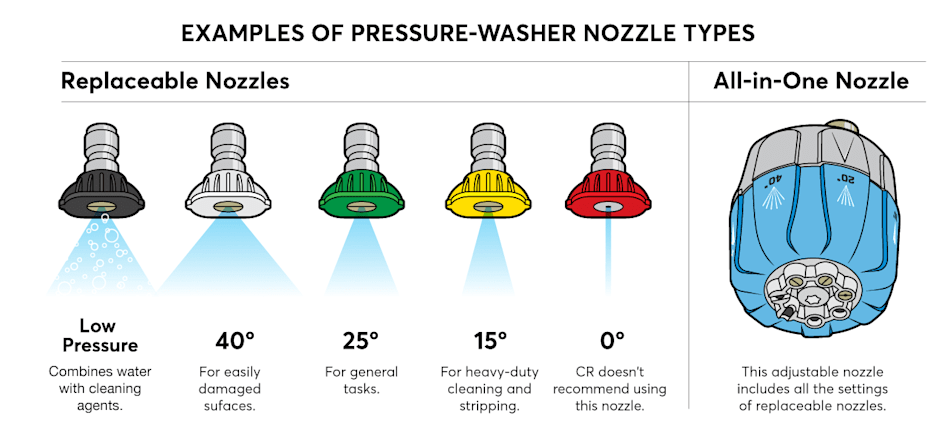
How to Choose a Pressure Washer

Home & DIY Editor

Senior Home & Tech Editor
A pressure washer (also called a power washer) is the perfect tool to work cleaning magic on concrete, decking, walkways, patios, steps, and more. The best pressure washers can erase months or even years of stains with a brief blast.
And by enabling you to completely refresh your wood deck instead of replacing it, pressure washers can also help you save money. It can amount to thousands of dollars in the bank, considering the current state of inflation and high lumber prices.
But not all pressure washers are alike. While all of them will clean more effectively than a garden hose, CR’s expert testing proves that some are more efficient at removing grime than others. Here’s what to look for in a pressure washer and how to use the tool effectively and safely.
Pressure Washer Basics
How Pressure Washers Work
Pressure washers use a gas engine or an electric motor to power a pump, which forces water at high pressure through a concentrating nozzle. The resulting blast washes away accumulated grime on surfaces such as decks, driveways, and patios. It can also be used to clean other items, like outdoor chairs and some types of siding, in a fraction of the time it would take with a scrub brush and hose.
Suitable Surfaces for Pressure Washers
Before you decide on which pressure washer to buy, make sure you actually need one. Driveways and walkways can be safely cleaned with a pressure washer, but that’s not necessarily the case with roofing, siding, and cars. See "Can This Surface Be Pressure Washed?" to learn whether a pressure washer is right for your situation.
Pressure Washer Parts
Whether you’re shopping for a gas pressure washer or an electric one, pay attention to the nozzle (or nozzles), hose, and—in the case of an electric model—power cord. We discuss nozzles below. As for hoses and power cords, the longer they are, the more mobility you have. Ideally, each should measure at least 30 feet.
Extra Features
If you often need soap, solvents, or other additives, consider a pressure washer that has a built-in soap tank. Tool and cord storage is a plus, as are wheels for heavier models.
Safety Risks
Pressure washers aren’t merely garden hoses on steroids. The nozzles shoot water at 30 to 80 times as much pressure as a hose and have surprisingly strong cutting capabilities, no matter which spray setting you use. In fact, a misplaced jet of water could land you or a bystander in an emergency room. Use all pressure washers with caution. For more details, see the pressure washer nozzle chart and tips below.
Hearing Protection
If a model does well in our noise tests (typically electric models), you can safely work without hearing protection—but only if the hose allows you to work at least 25 feet from the washing unit. If a model is noisy in our tests (typically gas models), wear earplugs or earmuff-style headsets.
Renting vs. Buying
Renting rather than buying a pressure washer allows you to skip the hassle of upkeep and storage. It’s also an option if you need a hot-water pressure washer, which is intended for professional use. We test only cold-water pressure washers, which should take care of the vast majority of household cleanup jobs. Buying a unit will pay for itself in a few years as long as you take care of it. Our experts say that if you use a pressure washer three or more times per year, you’ll save money by buying your own.
Which Pressure Washer Should You Buy?
Gas models are known for their power, but that’s not the only feature to look for when considering what to buy. Electric pressure washers—which include battery-operated models—have advantages, too. As a rule, the best midrange gas pressure washers will clean about 50 percent faster than the average electric model. But the best electrics can perform nearly as well. Here’s what to keep in mind.

Gas Pressure Washers
Pros: Deliver highest-pressure water. Quickly clean large areas, such as decks, siding, and driveways, without the need for harsh chemicals. Deftly dispatch tough gunk, such as chewing gum and tree sap. More pressure means a nozzle set on a wider angle will clean just as well as an electric model run on a narrower setting.
Cons: Relatively noisy and heavy. They require tuneups. Idling for long periods can overheat the pump, possibly ruining the machine if the safety valve fails. Pumps must be winterized with antifreeze in colder climates, and gas machines shouldn’t be stored inside a home. More power also means an increased risk of injury. There’s also a greater chance of gouging, splintering, or etching wooden surfaces, or inadvertently chipping paint.
Price: $250 to $500

Electric Pressure Washers
Pros: Best for small decks and patios, outdoor furniture, and other small jobs that require mainly cleaning instead of stain removal. These models are relatively light and quiet, require little upkeep, and create no exhaust. They start and stop conveniently. They don’t need winterizing, but battery models should be brought indoors during cold weather. Their small size makes them easy to store.
Cons: Lower water pressure makes for longer cleaning time. Wands and nozzles are made of plastic and are less sturdy than the metal fittings found on gas-powered models. Your cleaning area is limited to the length of your unit’s cord and hose. Hoses are typically 25 to 30 feet; power cords are around 35 feet.
Price: $90 to $350

Battery Pressure Washers
Pros: These tools use a lithium-ion battery for power. While they all used to be weak substitutes for gas or corded-electric machines, the best battery-powered pressure washers now offer solid cleaning performance. The batteries used in these tools can sometimes also power other tools, like cordless drills, from the same manufacturer.
Cons: Although several battery-powered pressure washers can perform deep cleaning, many models are still underpowered, maxing out around 600 pounds per square inch. (High-performing models we’ve tested are in the 3000- to 3,200-psi range, putting them on par with many gas-powered washers.)
Price: $125 to $800
How to Choose a Pressure Washer Nozzle
Pressure washers are sold with either a set of color-coded interchangeable nozzles or an all-in-one adjustable nozzle. Both types (illustrated below) allow you to change the angle (or spray vertex) of water depending on the task.
Adjustable nozzles are more convenient than replaceable ones; a twist is all it takes to change the spray width or pattern. But replaceable nozzles let you know the exact spray angle you’re using and help avoid creating a water stream that’s too fine, which can be dangerous.
Pressure washers can be dangerous if you use a very fine nozzle, especially a zero-degree nozzle—the water can tear through skin and the tissue beneath. That’s why Consumer Reports doesn’t give its CR Recommended designation to any pressure washer with a zero-degree nozzle or setting, no matter how well it cleans.
We also advise that you get rid of the red zero-degree nozzle if you decide to purchase a model that comes with one, and we strongly suggest that you avoid using pinpoint settings on adjustable nozzles. This will reduce the chance of damaging property or causing injury.
Higher-degree nozzles or settings can get the job done without unnecessary risk; it will just take a bit longer.

Illustrations: Chris Philpot Illustrations: Chris Philpot
Proper Care & Maintenance
Proper maintenance of a pressure washer will help you get the best performance and prolong the life of your equipment. It’s important to take care of it both before the first use and after the last use of the season to keep your pressure washer in tip-top shape. Gas-powered models require a bit more maintenance than electric or battery models.
When servicing a pressure washer, always follow the maintenance and safety procedures for your machine. And make sure to do the proper prep work before using the tool for the first time.
Check the manual. If your pressure washer is new, start by reading through the owner’s manual to see if there are maintenance recommendations for your specific model. Different washers may have unique requirements.
Inspect all connections and hoses. Before you start your cleaning project, inspect the machine for anything that might cause a problem. A good place to start is the connections and hoses. Look for any cracks or leaks, as well as loose fittings, and replace worn or broken parts. Don’t try to repair hoses, which operate at high pressure levels. Then check the O-rings on the ends of the hose for wear and tear. Damaged O-rings can cause serious problems, including leaking and even injury during use. If one is damaged, replace it before use. Finally, make sure the nozzles can connect securely and lock in place.
Inspect the debris screens. Dirt and debris can get caught in the screens or filters and block the flow of water. Check all screens and clean if needed.
Check oil (and gas) levels. For gas-powered units, confirm that the engine has the recommended type and amount of oil. It’s best to start with fresh gas, but if there’s still gas in the tank from the previous season, add a stabilizer and top it off with fresh gas of the right octane. Change the oil if it hasn’t been changed recently. Although electric models don’t require engine oil, the pumps on all types of power washers may require oil as well. Inspect and fill if needed using the correct type of pump oil based on the recommended maintenance schedule for your specific model.
Check the spark plug. If you have a gas model, make sure the spark plug is free from corrosion. Corroded spark plugs can make it difficult or impossible to start a gas pressure washer. Replace if needed.
Flush the system. Run clean water through the washer without the nozzle attached for about a minute to clear out any debris that could clog or damage the pump. However, make sure you have an adequate flow of water, as an insufficient supply can cause the pump to overheat, which can lead to pump damage.
Test the Nozzles. Make sure each nozzle sprays evenly and is free of blockages. Running the washer with a blocked nozzle can build up pressure and possibly cause the hose to spring leaks. If a nozzle is blocked, clean it with the supplied cleaning tool or a thin wire.
Make sure the unit is turned off when you’re done for the day—or the season. If it’s an electric model, disconnect the power cord or remove the battery.
Take care of the engine at the end of the season. If you have a gas model, run the engine until the tank is empty. Otherwise, fill the tank to reduce the amount of condensation, and add a gas stabilizer. Remove and oil the spark plug to prevent corrosion.
Give the washer a flush in preparation for storage. Clean the unit by flushing fresh water through the system to remove detergent or chemical residue. This prevents buildup and corrosion. Wash away any dirt and grime from the unit that could affect performance next season.
Drain the water completely. Disconnect all hoses and tilt the washer to drain as much water as possible. Leftover water can freeze and damage the pump in cold weather. Locate the chemical/detergent intake and clean it thoroughly with water. Make sure any residue or buildup is rinsed clean so that the water running out of the intake is clear.
Add a pump saver. Use a pump-protection solution to lubricate seals and prevent mineral deposits. This optional but recommended step is especially helpful before long-term storage.
Store it safely: Store your pressure washer in a dry, well-ventilated space away from the elements. If possible, protect it from freezing temperatures. Hoses should be loosely coiled to avoid kinks.
Pressure Washer Brands
Briggs & Stratton, a large manufacturer of gas pressure washers, also makes the gas engines used in models from other brands.
Champion makes gas pressure washers sold online and at smaller dealers as well as on Amazon.
Formerly the house brand of Sears, Craftsman now sells gas and electric pressure washers at Lowe’s and a small number of Ace Hardware stores.
A large manufacturer of gas-powered pressure washers, with models sold online and at smaller dealers.
A large tool company that sells gas-powered pressure washers online as well as at Home Depot.
Generac makes gas pressure washers sold at hardware stores and home centers, including Home Depot.
All the pressure washers Greenworks makes are electric, and it’s one of the largest players, with models available at Tractor Supply and Lowe’s stores.
Kärcher was one of the earlier manufacturers of electric pressure washers. It sells models on Amazon and at Home Depot.
NorthStar is one of the only manufacturers of 240-volt electric pressure washers, which produce power on a par with gas models. Look for NorthStar models at private dealers.
Predator, the house brand of Harbor Freight tool stores, offers competitively priced gas pressure washers.
Ryobi is a Home Depot-exclusive brand that makes aggressively priced gas and electric pressure washers.
Simpson makes gas- and electric-powered pressure washers. Its models are sold online as well as at Tractor Supply and Home Depot.
Sun Joe makes electric pressure washers that are sold online as well as at Home Depot and Lowe’s stores.



























